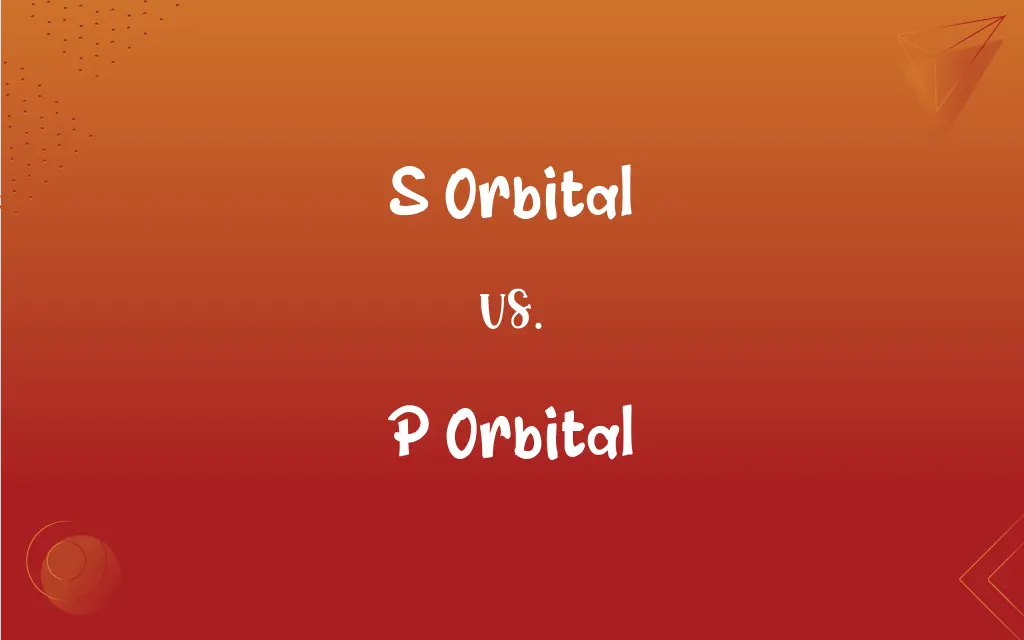S Orbital vs. P Orbital: What's the Difference?
Edited by Janet White || By Harlon Moss || Updated on October 23, 2023
The s orbital is spherical in shape while the p orbital is dumbbell-shaped.

Key Differences
The s orbital represents the simplest type of atomic orbital, which is spherical in shape. On the other hand, the p orbital is a more complex type of atomic orbital, having a dumbbell-like shape.
In terms of energy levels, the s orbital is the first to fill in a given shell, indicating it generally has a lower energy compared to the p orbital in the same shell. The p orbital fills after the s orbital within the same principal quantum number.
Every principal energy level has only one s orbital, implying a maximum of two electrons (due to spin) can occupy it. Contrarily, there are three p orbitals (px, py, pz) in each energy level starting from the second principal quantum number, which means they can collectively hold up to six electrons.
Electron cloud density in the s orbital is uniformly distributed around the nucleus, giving it its spherical appearance. In contrast, the p orbital has two lobes with a nodal plane passing through the nucleus, which results in its unique dumbbell shape.
As for electron configurations, the s orbital gets filled before the p orbital in the Aufbau principle. For instance, 2s fills before 2p, and 3s fills before 3p.
ADVERTISEMENT
Comparison Chart
Shape
Spherical
Dumbbell-shaped
Number in Each Level
1
3 (px, py, pz)
Electron Capacity
2 electrons
6 electrons (2 in each of the three orientations)
Distribution of Cloud
Uniformly distributed around the nucleus
Two lobes separated by a nodal plane
Filling Sequence
Fills before the p orbital in the same energy level
Fills after the s orbital in the same energy level
ADVERTISEMENT
S Orbital and P Orbital Definitions
S Orbital
The s orbital is an atomic orbital with a spherical shape.
The 1s orbital in hydrogen contains a single electron.
P Orbital
Electron density in the p orbital exists in two lobes separated by a nodal plane.
The electron cloud of the p orbital displays a dumbbell shape due to its lobed distribution.
S Orbital
It is the first orbital to fill within its respective principal quantum number.
Before any p orbitals fill, the s orbital in the same shell gets filled first.
P Orbital
It consists of three orientations in a given energy level starting from the second principal quantum number.
The 2p orbitals include px, py, and pz.
S Orbital
It represents the lowest energy atomic orbital in a given principal quantum number.
In the second shell, the 2s orbital fills before the 2p orbitals.
P Orbital
It is higher in energy than the s orbital within the same principal quantum number.
In the third shell, the 3s orbital fills before the 3p orbitals.
S Orbital
The s orbital can hold a maximum of two electrons.
Helium has both electrons in the 1s orbital.
P Orbital
The p orbital is an atomic orbital with a dumbbell-like shape.
Each of the three p orbitals lies along a different axis: px, py, and pz.
S Orbital
Electron density in the s orbital is uniformly distributed around the atomic nucleus.
The electron cloud of the s orbital is spherical due to its uniform electron density.
P Orbital
The p orbital can collectively hold up to six electrons.
Neon's outer shell has six electrons distributed among the three 2p orbitals.
FAQs
How many electrons can an s orbital hold?
An s orbital can hold up to 2 electrons.
How many orientations or types does a p orbital have?
The p orbital has three orientations: px, py, and pz.
In which energy level does the p orbital first appear?
The p orbital first appears in the second energy level.
How many p orbitals are there in the third energy level?
There are three p orbitals in the third energy level: 3px, 3py, and 3pz.
Which orbital fills first, the s orbital or the p orbital?
The s orbital fills first before the p orbital in the same energy level.
Is the electron density distribution uniform in the s orbital?
Yes, the electron density in the s orbital is uniformly distributed.
Are the 2s and 2p orbitals in the same shell?
Yes, both 2s and 2p orbitals are in the second shell.
Which has higher energy in the same shell, s orbital or p orbital?
The p orbital has higher energy than the s orbital in the same shell.
Do electrons prefer to fill the s orbital or p orbital first?
Electrons prefer to fill the s orbital first before moving to the p orbital.
Which has a more complex shape, the s orbital or the p orbital?
The p orbital has a more complex, dumbbell shape compared to the simple spherical shape of the s orbital.
Are the s and p orbitals the only types of atomic orbitals?
No, besides the s and p orbitals, there are also d and f orbitals.
What shape is the s orbital?
The s orbital is spherical in shape.
How does the shape of the p orbital differ from the s orbital?
The p orbital is dumbbell-shaped, unlike the spherical s orbital.
Does the p orbital have any nodal planes?
Yes, the p orbital has a nodal plane that passes through the nucleus.
In electron configurations, which is denoted first, the s orbital or p orbital electrons?
In electron configurations, the s orbital electrons are denoted before the p orbital electrons for the same principal quantum number.
Are there any elements that only have electrons in the s orbital?
Yes, hydrogen and helium have electrons only in the 1s orbital.
How many s orbitals are in the fourth principal quantum number?
There is one s orbital in the fourth principal quantum number, labeled as 4s.
Can the first energy level have a p orbital?
No, the first energy level only has an s orbital.
How is the spatial orientation of the p orbitals?
The p orbitals are oriented along the three spatial axes: x, y, and z.
How many electrons can the three p orbitals combined hold?
The three p orbitals combined can hold up to six electrons.
About Author
Written by
Harlon MossHarlon is a seasoned quality moderator and accomplished content writer for Difference Wiki. An alumnus of the prestigious University of California, he earned his degree in Computer Science. Leveraging his academic background, Harlon brings a meticulous and informed perspective to his work, ensuring content accuracy and excellence.
Edited by
Janet WhiteJanet White has been an esteemed writer and blogger for Difference Wiki. Holding a Master's degree in Science and Medical Journalism from the prestigious Boston University, she has consistently demonstrated her expertise and passion for her field. When she's not immersed in her work, Janet relishes her time exercising, delving into a good book, and cherishing moments with friends and family.






































































